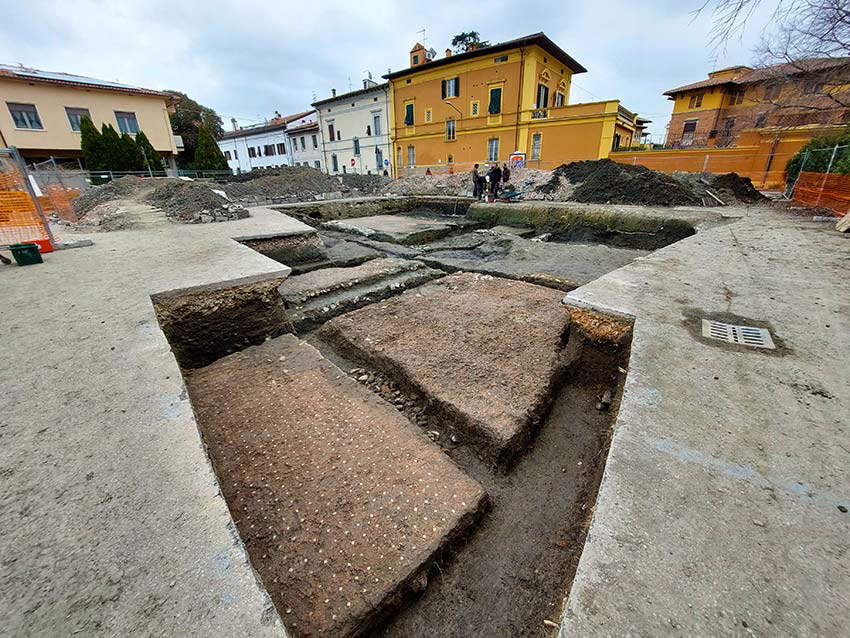In Pisa , the remains of several Roman domus have been found a stone’s throw from the Tower. The archaeological excavation in Piazza Andrea Del Sarto, directed by Professor Fabio Fabiani of the Department of Civilizations and Forms of Knowledge at the University of Pisa, began last September 2022 and, after a short break, was reopened in January 2023. Investigations so far have uncovered the remains of one or more Roman domus from the early first century AD, provided with exceptionally well-preserved decorated floors and uncovered spaces, probably gardens flanked by porticoes. The eaves were bordered by terracotta drips, of which a fragment of a lion’s head was part.
Among the best-preserved rooms is a triclinium (a dining room), where diners ate and conversed while lying on three beds arranged on the sides and at the back of the room, around a floor panel, a kind of richly decorated carpet. Next among the finds are large quantities offragments of the wall coverings, in painted plaster, which retain extremely vivid colors and indicate the considerable level of wealth of the inhabitants. Finally, many furnishings have been found: crockery that still bears the hallmarks of Pisan workshops from the 1st century AD, transport containers for wine, oil and fish sauces, oil lamps, game tokens, engraved gems and numerous coins.
At present, the excavation has covered only a portion of the square, but the remains of ancient structures certainly extend over the entire area. It is likely that the domus belonged to the same residential neighborhood as the dwellings already excavated in the nearby Piazza dei Miracoli, flanking the ancient Auser River. The latter, now disappeared from the urban landscape, in fact characterized, along with the Arno, Roman Pisa.
The excavation in Piazza del Sarto also investigated a further stretch of this ancient river, in addition to the one already excavated at the Pisa San Rossore station where the wrecks of the now famous Roman boats were found. Among the sands of the ancient riverbed, large quantities of transport containers, goods of various kinds and fragments of the wooden planking of ancient boats were recovered. In the following centuries this area was gradually abandoned. In the 4th century AD, when by then the domus had ceased to be used, this area of the city continued to be frequented: evidence of this can be seen in the remains of structures (walls and earthen floors) and pottery that the excavation allowed to be recovered. Between the late 4th-5th centuries AD, in the area that had now become peripheral, people began to bury the dead in simple pits dug in the earth. Finally, between the 6th and 7th centuries AD, the area became a salvage site for building materials. At a time when the city was evidently ’hungry’ for materials to build new works, operations were begun to dismantle the walls of the domus in order to recover their stones. The traces of this intervention are long and deep trenches that run through the entire excavation.
The occasion of the archaeological investigations was provided by the excavations for the laying of pipelines carried out by Acque SpA. Archaeology students from the University of Pisa and beyond, research fellows, doctoral students and residents are participating in the excavation.
 |
| Pisa, remains of some Roman domus discovered near the Tower |
Warning: the translation into English of the original Italian article was created using automatic tools. We undertake to review all articles, but we do not guarantee the total absence of inaccuracies in the translation due to the program. You can find the original by clicking on the ITA button. If you find any mistake,please contact us.